Our CCA Gum Poles are made from Eucalyptus Grandis trees. We firmly believe in only selling the best quality poles to our customers. Additionally, we care about our environment. We ensure that we are always working towards a better, greener future by reducing our carbon footprint and making use of the latest research to improve our farming, manufacturing, and transport processes.
it is with great confidence that we say our products are of the highest quality, strong, and durable. We believe that the Eucalyptus Grandis species tree would be ideal for our CCA pole products. This article is all about the value of Eucalyptus, its influences in South Africa, and why it is such a great quality wood.
EUCALYPTUS TREE

The Eucalyptus (also known as Flooded Gum, Gum, or Rose Eucalyptus) is a hardwood tree that originally comes from Australia and was introduced to South Africa in 1890. There are over 700 species of Eucalyptus. By 1973, 75% of these species were planted in South Africa. It was discovered that South Africa covers a much larger area with the best-suited climate for Eucalyptus than Australia. The plantation areas in South Africa fall into high rainfall zones resulting in the fast and effective growth of the Eucalyptus. This resulted in the Eucalyptus being the most extensively planted hardwood in these regions.
The Eucalyptus originates from Queensland (Northern Australia) where the maximum temperature of the hottest month across its distribution ranges from 24 °C to 30 °C, and the mean minimum temperature of the coldest month ranges around 7.3 °C – 19.4 °C. These temperatures are very similar to that of the Lowveld, Mpumalanga, in South Africa. This makes South Africa the ideal secondary place to grow Eucalyptus trees.
Characteristics of a Eucalyptus Tree
Eucalyptus has gained popularity in South Africa because of the many applications it can be used for, mainly in building construction. Here is a list of characteristics of a Eucalyptus tree:
- They are straight trees that can grow up to 50m in height.
- They are fast growing – on average of 8 years, they can reach an average height of 20m.
- They have a straight grain, which plays part in their strength and durability.
- The heartwood is pinkish in color which is a naturally attractive color.
- The flowers of a Eucalyptus tree do not carry petals.
MEDICINE
Eucalyptus extract can be found in various over-the-counter drugs, cleaners, and even air fresheners. It is available to use in different forms.
Leaves – can be used for therapeutic and medicinal purposes and can be made into a tea that’s safe for consumption.
- It acts as an antioxidant, particularly flavonoids, which protect your body from oxidative stress and protects you from radical damage (damage to nerves that travel down the arm and controls of your body). Eucalyptus leaves may also protect against certain cancers, heart disease, and dementia.
- Known as an ingredient in cold medicines, Eucalyptus can help relieve flu symptoms.
- Leaf extract contains a compound called Macrocarpal A, which can be used to treat dry skin, dandruff, or skin disorders like dermatitis.

Oil Extract – Many over-the-counter cold and flu medicines have Eucalyptus as an ingredient. Eucalyptus oils are used in creams and ointments to relieve muscle and joint pains also to relieve congestion.
- The cineole in Eucalyptus oil acts as an antiseptic that kills bacteria that cause bad breath. You may find eucalyptus oils in some mouthwashes.
- By using the steaming technique, Eucalyptus can help ease conditions such as asthma and sinusitis.
- If you apply eucalyptus to cold sores, it could help ease the discomfort and speed up recovery.
- It can be used to disinfect wounds.
It is important to know that ingesting eucalyptus oils can be very dangerous and is not recommended unless under supervision or suggested by a doctor.

EUCALYPTUS PLANTATIONS

The demand for wood has increased significantly over the course of the years. The South African Government started with extensive plantations as they found it would give South Africans the benefit of being self-sufficient when it comes to producing timber (Which is great for our economy) and it would also generate job opportunities.
The main objective of forest plantations is, to obtain a high degree of productivity, in other words, to achieve the fastest possible growth in the tree and obtain the greatest amount of wood and biomass, while occupying the smallest possible space. Plantations are carried out in forest areas, largely in soils without plant cover, or which are degraded or unused. According to a government article, the majority of plantations in South Africa are Pine, Eucalyptus, and Wattle.
While considering plantations for productivity etc. is an excellent idea, it is still important to also preserve our natural forests. This is where plantations play an important role. Fortunately, the commercial forestry industry in South Africa is committed to constantly practicing sustainable forest management to preserve our natural forests.
The importance of Forest Sustainability
Our natural forests inhabit by wildlife and vegetation which will not be found in any plantations. We must protect our ecosystem. Our ecosystem is responsible for cleaning our natural water sources, purifying our air, maintaining our soil, regulating the climate, recycling nutrients, and providing us with food. Our natural forests are also home to a variety of animal life and plants. Natural forests offer much more than any plantation ever can. We are all extremely dependent on our ecosystem services. Therefore, we must preserve and recover what is left of our natural resources.
Our natural forests also store more carbon due to their complex structures and the way carbon is gathered belowground and on the forest floor. Preserving and recovering our natural forests can make a difference in our future; according to Nature, “…letting forests regrow naturally has the potential to absorb up to 8.9 billion metric tons of carbon dioxide from the atmosphere each year through 2050, while still maintaining native grasslands and current levels of food production.”
Plantations can help fight deforestation
Environmental and industrial benefits of Eucalyptus Plantations
The South African Commercial Forestry Industry takes the practice of sustainable management seriously, and certain laws and regulations are in place to protect our plantations. There are many benefits that eucalyptus plantations hold which make them stand out above the rest:
Environmental Benefits

Eucalyptus trees store huge amounts of carbon
- The rapid growth of Eucalyptus plantations in particular, rapidly sequestrates large quantities of carbon from the atmosphere. Over the years increased commercial forests have gradually become the dominant carbon banks.
According to Cylix. Global, a Eucalyptus tree can store 15.7 tons of carbon per hectare, for every 4 years of growth. After a tree has been harvested, it remains to store carbon for as long as it is in use. Eucalyptus grows fast enabling them to store even greater amounts of carbon.
Eucalyptus trees are Water efficient and help to hydrate the soil
- Eucalyptus tree plantations are found in areas where the weathering conditions are tropical and humid most of the time. The trees take advantage of these weathering conditions (e.g. Fog) to consume water. There is therefore no need for water irrigation. Which means no dams or other water resources are affected. This also makes the trees self-sufficient.
- Eucalyptus trees can adapt their water consumption to the level of rain and the climate. “It may be noted that when it does not rain and the other trees turn yellow and parched, the eucalyptus stays green not because it has enormous reserves of water which is hoarded, but because it shuts off the stomas, and does not allow the water to escape through them. In other words, eucalyptus does not lose as much water by way of transpiration as other trees.” – Downtoearth.org
- The unique shape of a eucalyptus leaf allows a greater amount of water, sourced by rain and fog, to reach the soil, thus helping to replenish water levels.
Nutrients from the trees are supplied to the soil
- They improve and recover degraded soils which are unused or unusable. Their leaves and branches act as nutrients and are not acidic for the soil.
- The root systems of Eucalyptus trees do not grow deeper than 2m, therefore it does not cause any destruction in deep underground resources.
- Eucalyptus can be planted on slopes, Their shallow roots fix the upper ground soil which in turn minimizes erosion and offers slope stability.
Eucalyptus trees are good for biodiversity
- The functions of a Eucalyptus plantation act the same way as a natural forest. It may have fewer animals and other plants, but this is not the main purpose of a plantation. However, plantations create new spaces for animal and plant life development.
Plantations act as a haven or hiding place where animals may feel more protected, a quality that did not exist before.
- The flowers of eucalyptus trees are rich in nectar. Bees collect nectar as food for the entire colony. They produce honey from nectar. The flowers also provide food for nectar-feeding birds such as Hummingbirds and other insects.
Eucalyptus trees are moderately invasive
Like any other tree species, eucalyptus is a colonizing plant. Its seeds can spread but it is not as aggressively invasively as many other plants. Where there are open spaces close to the plantation, eucalyptus could start growing. However, these trees are not damaging to other tree species, and they do not hybridize naturally.
Industrial benefits
Mining industry
- Eucalyptus was acquired in South Africa because of the high demand for wood for mining industries. It was deemed ideal because of its rapid growth while still possessing exceptional strength. To this day, the mining industry uses eucalyptus as mine packs.
Pulp and Paper Industry
- South Africa is one of the world’s largest producers of pulp, paper, and paper products on the African continent. Eucalyptus is the main source for the production process, they are ideal because it offers low production cost with a high productivity rate.
Construction Industry
- The versatility and strength of Eucalyptus wood make it ideal for the construction industry. Construction material is always in high demand. Eucalyptus trees can be harvested anytime between 8 years and 30 years which means, as mentioned above, it has a high productivity rate.
EUCALYPTUS CCA GUM POLES

Eucalyptus poles already have good qualities in their natural state. However, by treating them with CCA, only more benefits, such as extra protection, are added. When working on any building project, we rely on materials that will work effectively and last long. While pressure-treated poles can stay up to 40 years without any signs of rot or decay. At Sabie Poles, we have a lifetime guarantee on all our CCA-treated timber products.
Tanalised CCA (Copper, Chrome, Arsenate) is a water-based wood preservative used to protect timber against common destructive organisms namely fungi, wood-destroying insects, marine borers, and bacteria.
Here are a few added benefits of CCA gum poles:
Sustainable:
Besides being a natural and renewable material, timber also acts as a storage bank for carbon (Co2). This is an important factor as Co2 is one of the key causes of global warming.
By constructing with timber rather than any other building material, you can reduce your carbon footprint. CCA gum poles can also be reused without the need to be re-treated.
Strong and durable:
Eucalyptus poles is a naturally strong hardwood. When treated, the strength of the wood is not affected however, it is more durable because it is protected against environmental impacts such as weathering, wood insects, bacteria, and fungi. The lifespan of CCA gum poles is extended by at least 45 years.
Versatile:
Sealants can be used for extra protection. CCA gum poles can also be painted or varnished according to desired colours.
The strength, durability, length, and diameter of Eucalyptus poles enable them to be used in multiple indoor and outdoor applications.
The use of CCA gum poles in building construction enables you to build your timber home in the most uneven, and isolated areas.
Readily available:
Eucalyptus trees grow very well in South Africa. Most Eucalyptus Forest plantations are in Mpumalanga. By buying your timber from a reliable and reputable supplier such as Sabie Poles, you can rest assured stock is always readily available.
Maintenance-free:
After treatment, the poles are protected against weathering elements, and there is no risk for the poles to dry out or crack. Applying sealant for extra protection is optional. Other than wiping the dust now and then, no other maintenance is needed.
Safe:
Our CCA gum poles are SABS-approved. This means they have been inspected for defects that could cause structural complications. They are safe to handle as the chemicals are completely fixed in the wood.
Identifying Top-Quality CCA Gum Poles
The Poles undergo a series of inspections and tests before and after they are treated to ensure that only the best quality timber is sold to our consumers. This is a legacy that Sabie poles have upheld since the 1990s. Our quality standards exceed far more than our client’s expectations.

During the inspection and grading process, each pole should meet the following specifications:
- The poles should be straight.
- The poles must have the correct diameters.
- There should only be standard allowable cracks/splits with no spirality in the wood.
- Knots should be tight and not protrude.
- Wane/bark should be completely removed.
- There should not be any mechanical damages
- Damage caused by handling equipment such as Bells and chainsaws.
- The poles must have sapwood of 13mm and more, but sapwood must not be more than 80% of diameter as this will weaken the pole.
It is important to be able to identify a quality CCA pole. There are many dishonest retailers out there that are trying anything to make a buck.
Every CCA-treated pole will have a steel anti-split plate with the SABS stamp of approval. Additional information will be, the treatment class, year of treatment, and company name.
Freshly treated CCA timber can be identified by its yellow/greenish-to-green colour that fades over time into a weathered silver-grey if exposed to the weathering elements.
Additional treatment for CCA Gum Poles
CCA-treated poles are treated for protection against weathering elements fungi, decay, and insects. However, by using sealants, you only add to the protected value of CCA gum poles. Timberlife sealants and stains are best recommended for CCA gum poles as it is known to be 100% compatible.
Sealants
CCA gum poles can be sealed with sealants for additional protection. Khuni Sealer is a Timberlife penetrating solvent-borne sealer that provides a durable high-sheen finish with good flexibility. It contains a unique blend of drying oils, high-quality resins, water-repellent wax components, and UV-resistant transparent iron oxide pigments.
Stains
Avoid solid stains because these finishes eventually peel and require a significant amount of maintenance. Timberlife Stain is a superior organic solvent-based wood stain that consists of high-quality transparent iron oxides that don’t hide the grain of the timber and can be used as an interior or exterior wood stain. Stain also imparts excellent U.V protection to timber that is exposed to permanent direct sunlight.
We have the following Timberlife Stain products available in eight shades of brown, namely:
Mahogany / Walnut / Oregon / Teak / Dark Oak / Imbuia / Kiaat / Golden Brown

Uses for CCA Gum Poles
Because the poles are used for so many different applications, it is important to use the treated timber by the required hazard classification. To read about the different treatment classes, please click on this link: Treatment Classes.
CCA gum poles can be used for multiple applications indoors and outdoors. Their length, structure, and strength make them versatile enough to be used in applications such as utility, highway, marine, agricultural and heavy construction. Here is a list of basic uses for CCA gum poles:
Agriculture with CCA gum poles

Netting
Farmers use netting to reduce potentially harmful effects caused by weather elements such as the wind, sun rays, hail, and drought. It is also used to protect plants from insects and birds. It also helps to provide conditions for the production of photosynthesis (the process by which plants use sunlight, water, and carbon dioxide to create oxygen and energy in the form of sugar.) and to increase humidity while decreasing evaporation.
This is a good method to use for the best results in fruit and vegetable production. CCA gum poles are used as support structures for the netting. Common Poles sizes used for shade netting are lengths of 5.4m – 6.6m with diameters of 100mm, 125mm & 150mm.

Fencing
Fences on farms play an important role in keeping the farm animals safe and within their permitted area. Every farmer should have a fence to make the boundaries of their property visibly clear. Fences are also important to prevent outsiders from trespassing.
CCA gum poles used for fencing are treated with H4 hazard class treatment, for in-ground-contact use. 2.4m poles are mostly used for farm fences.
1.8m droppers treated with H3 hazard class treatment, above-ground contact, are placed between the poles to keep the fencing lines intact. Animals such as cows may tamper with the lines to try to get through.
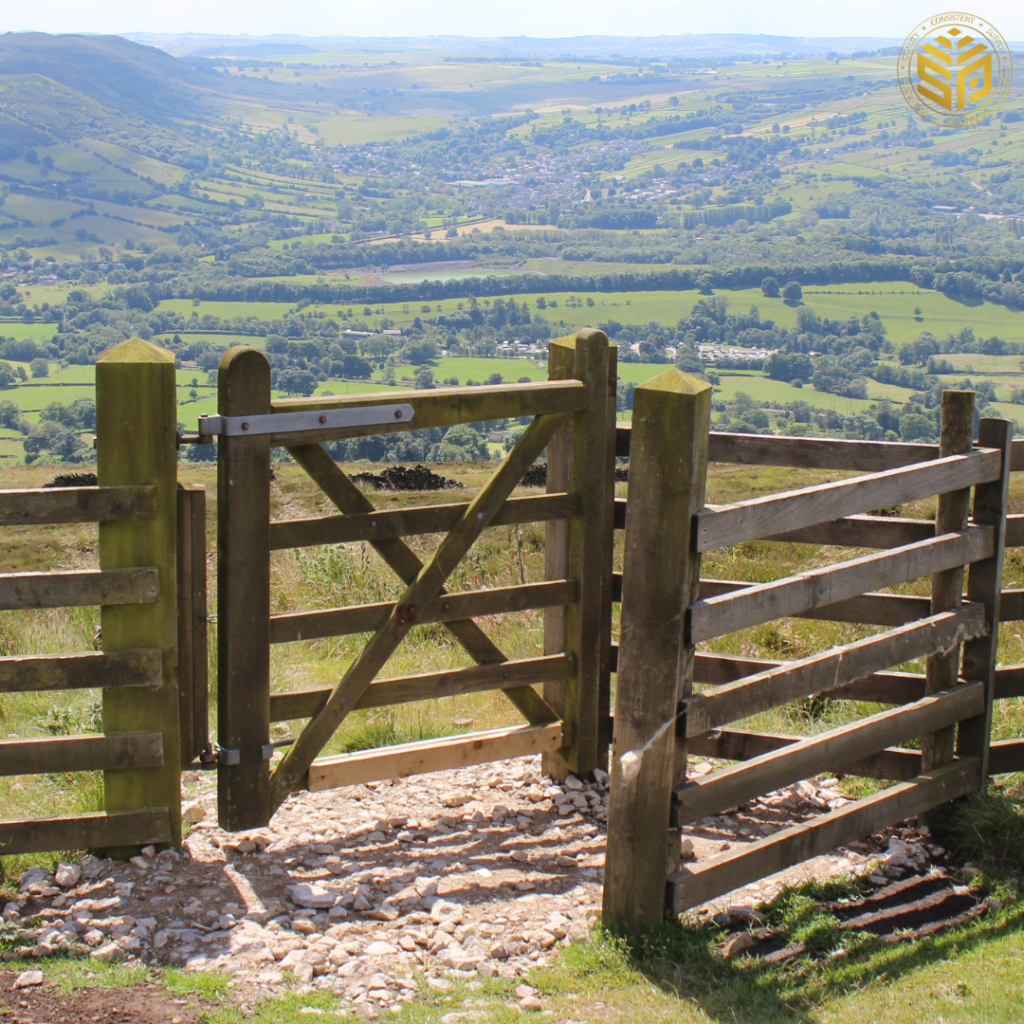
Gates
In South Africa, especially on our farms, gates can be built using CCA gum poles. It serves as a great way to keep livestock in as well as add to the romantic feel of your homestead.
More people want sophisticated designs where a combination of iron and timber is used. When designing a gate, it is important to remember that wood/timber and poles deteriorate with exposure to sun and rain over time. Therefore, it is important to use CCA pressure-treated timber. Pole gates also can be that finishing touch by blending in with your pole fence.
Cattle Kraal / Pen
Cattle pens are enclosed constructions used for confining cattle. The poles used to build this structure are treated with h5 hazard class treatment. The H5 Treatment class is for use in applications where there will be in-ground contact and there is constant or periodic moisture in the ground. Moisture is mostly caused by cattle urine and rain. Cows and bulls tend to push and lean against fences. A kraal needs to be able to withstand all of the pressure from the animals daily, CCA gum poles are ideal for this application because of their known characteristic of being strong and durable.
The CCA gum poles are used for the following:
Corner posts
We suggest using 150mm – 200mm poles as they will withstand the pressure of the cattle when they lean against the fences. Lengths can vary from 1.5m – 2.4m.
Uprights spaced between the corner posts
When using wires for fencing, the uprights should always be a thickness of 100mm – 150mm.
Cross beams
To keep the kraal intact the crossbeams should range from 76mm – 90mm thick.
Trellis
Trellis is mainly used to enable fruit and vegetable to grow upwards. They are ideal if you only have a limited space for fruit and a garden. Trellis comes in various custom shapes and sizes and the versatility characteristic of poles makes them the ideal material to use for such applications, besides the fact that it is a natural material that just blends in with nature.
There are many benefits to having a trellis in your fruit and vegetable garden such as a decreased risk of insect damage, the ease of crop harvesting, and much more.
CCA gum poles are durable, and because of the way it is treated, these poles serve no harm to your plants. Examples of plants growing vertically are:
- Fruits such as grapes, strawberries, cherry tomatoes, kiwi, and passion fruit.
- Vegetables such as green beans, cucumber, and pumpkins.
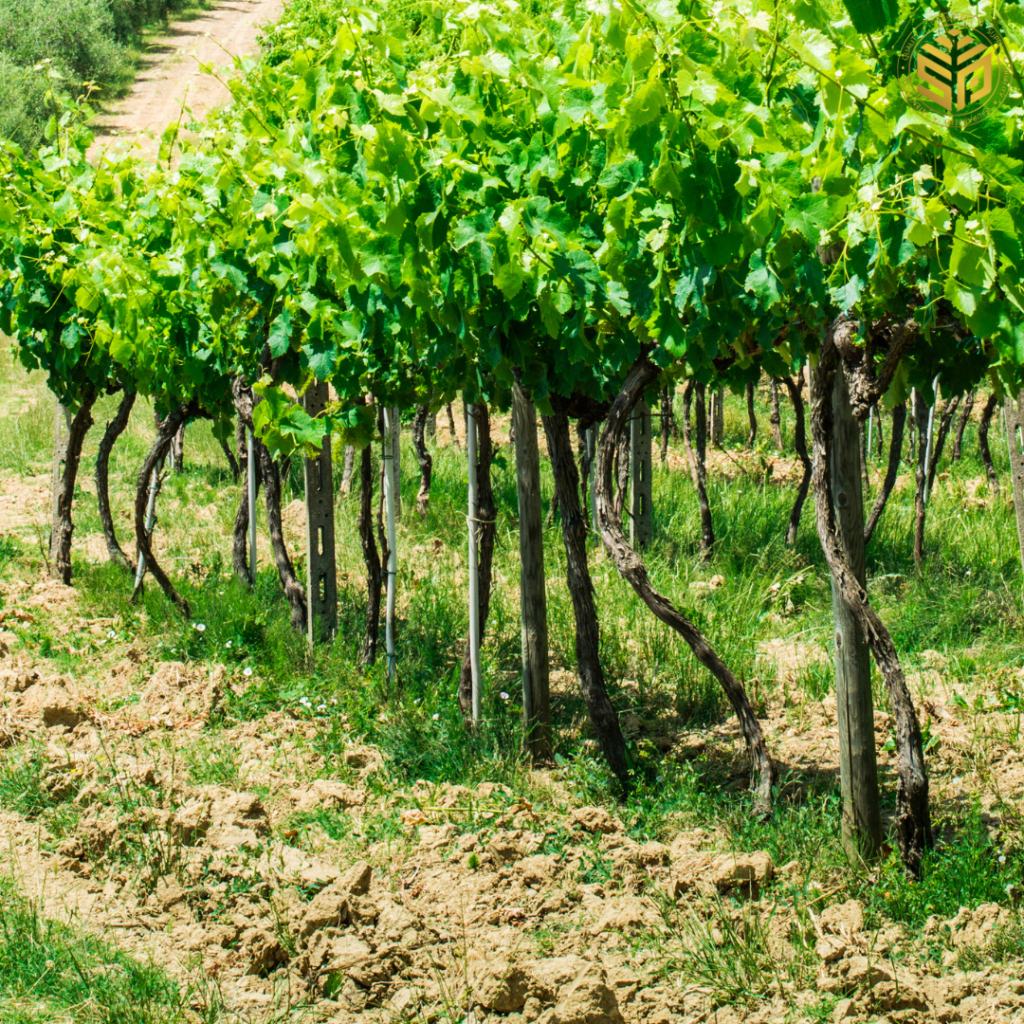
Tree stakes
When planting a new tree, enough water, sunlight, nutrients, and a little bit of pruning now and then are needed. But that’s not all, your tree may need a support structure to help it grow correctly, and this is where the role of stakes comes in. laths and droppers may be used for this application.
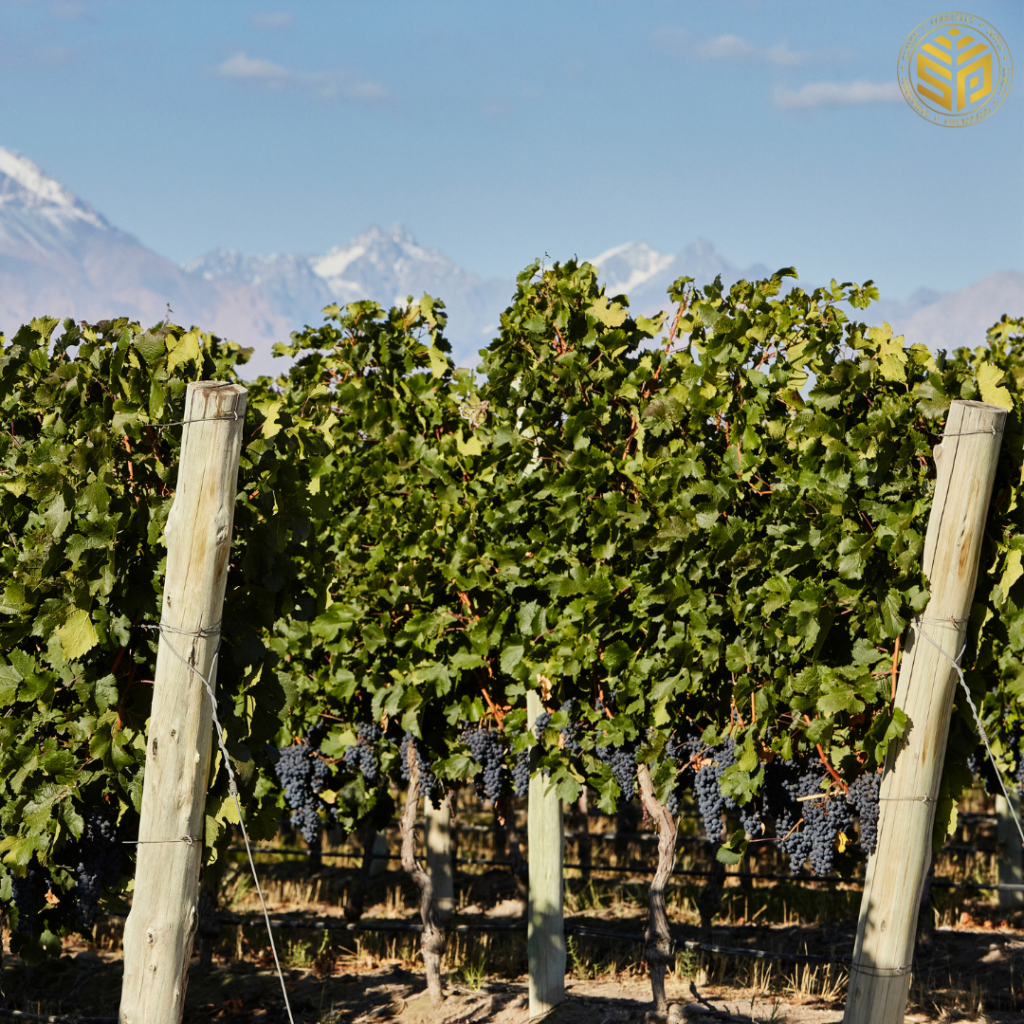
Vineyards
Poles are used for the productive growth of grapes for wine. Poles are most preferred because of the ease of making holes in the poles to thread wiring for the grapes.
Another important factor is that the CCA gum poles are treated to tolerate wetness which is present with irrigation. Wood is also a biodegradable material making it environmentally friendly by not contributing to any environmental pollution.
The most common Poles sizes used for this application are 75mm in diameter with lengths of 3m and 3.6m.
Construction with CCA gum poles

Structure Piles
Piles are used to support structures that carry a heavy load capacity. Examples are, building structures such as timber houses and log houses. Piles enable builders to build structures in the most remote and uneven areas. Piles are very beneficial as they are more tolerant to erosion.

Bridges
Poles are used as piles that are hammered into the soil beneath the bridge until the end of it reaches the hard sub-layer of compacted soil or rock below. These piles support part of the load of the bridge deck. Fortunately, we have CCA gum poles with lengths of up 15 meters, so bridges can be built quite high. Guard rails, when preventing people or vehicles from falling off can also be built using CCA gum poles.
Some bridges are built to cross water, in this case, piles will need to be built in the water. CCA gum poles that are treated with H5 class treatment work perfectly for use in fresh water and H6 class treatment works perfectly for use in seawater.
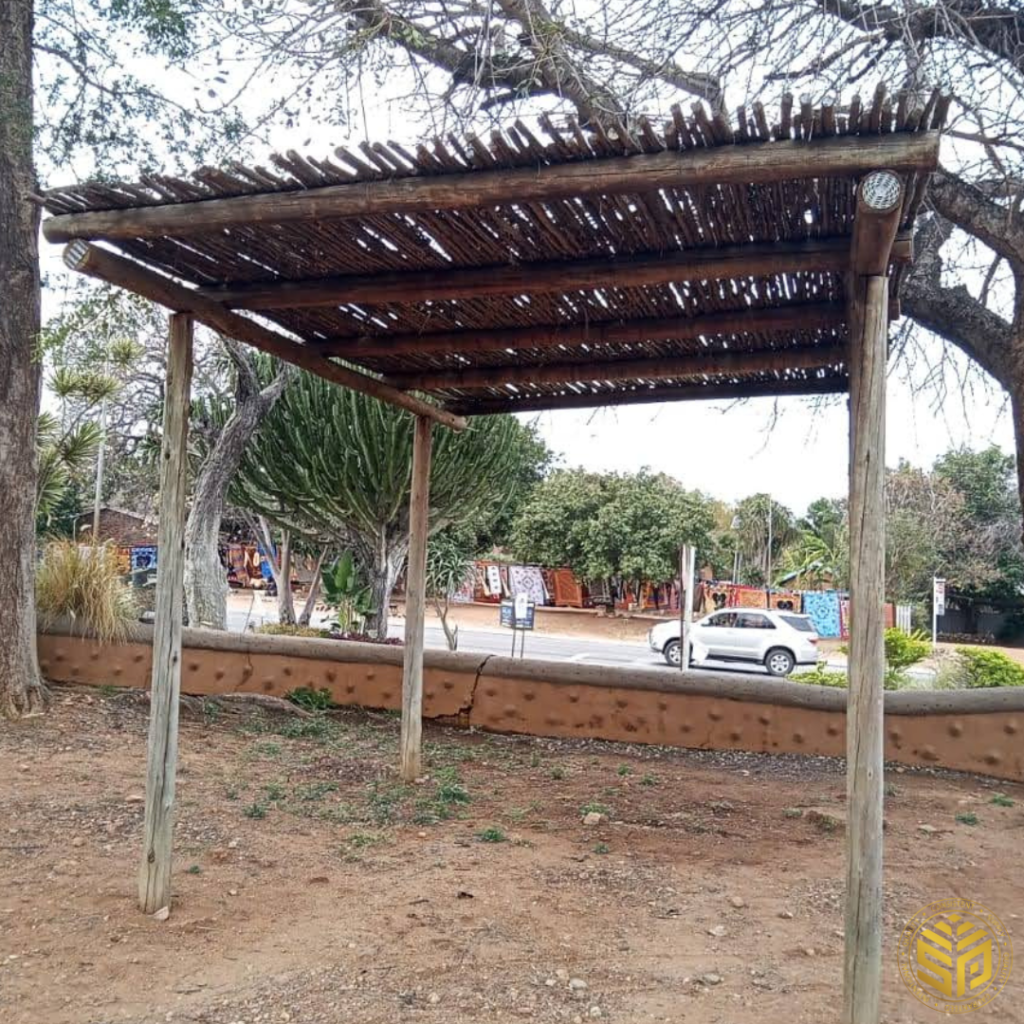
Carports
Creating a shaded space to prevent the sun from damaging your vehicle over time, is a good idea. By using CCA gum poles, you can build a stunning carport while saving costs and it could last you a lifetime. If you are interested in building a carport, you are welcome to read our blog by clicking on this link: Carport

Thatched Roof
Many people prefer thatched roofs because of their insolation qualities, it keeps the inside of a building warm or cold days and cool on hot days without the need for appliances such as aircon.
To construct the framework of a thatched roof, CCA gum poles of various sizes (depending on the size of the roof) are used. The thatching battens are made of laths (which are thin gum poles with a diameter of 20mm – 32mm). Additionally, square-cut poles can be used to support the roof structure.

Beams
Beams are mainly used in roof structures; it acts as a support structure to the whole roof. CCA gum poles or square-cut poles can be used for this application.

Guard rails / Barricades
These systems are used to keep people or vehicles away from dangerous areas, they are mainly used on the corners and sides of roads and highways.

Tank stands
These stands are made from Slabbed Bearers (poles that have been cut at the bottom and the top). CCA gum poles can also be used as piles for the stand if it is required that the tank should be high above the ground.
CCA gum poles are strong enough to handle the huge amount of weight that water tanks consist of. The poles are also treated to prevent rot in the case of recurring water spillage.
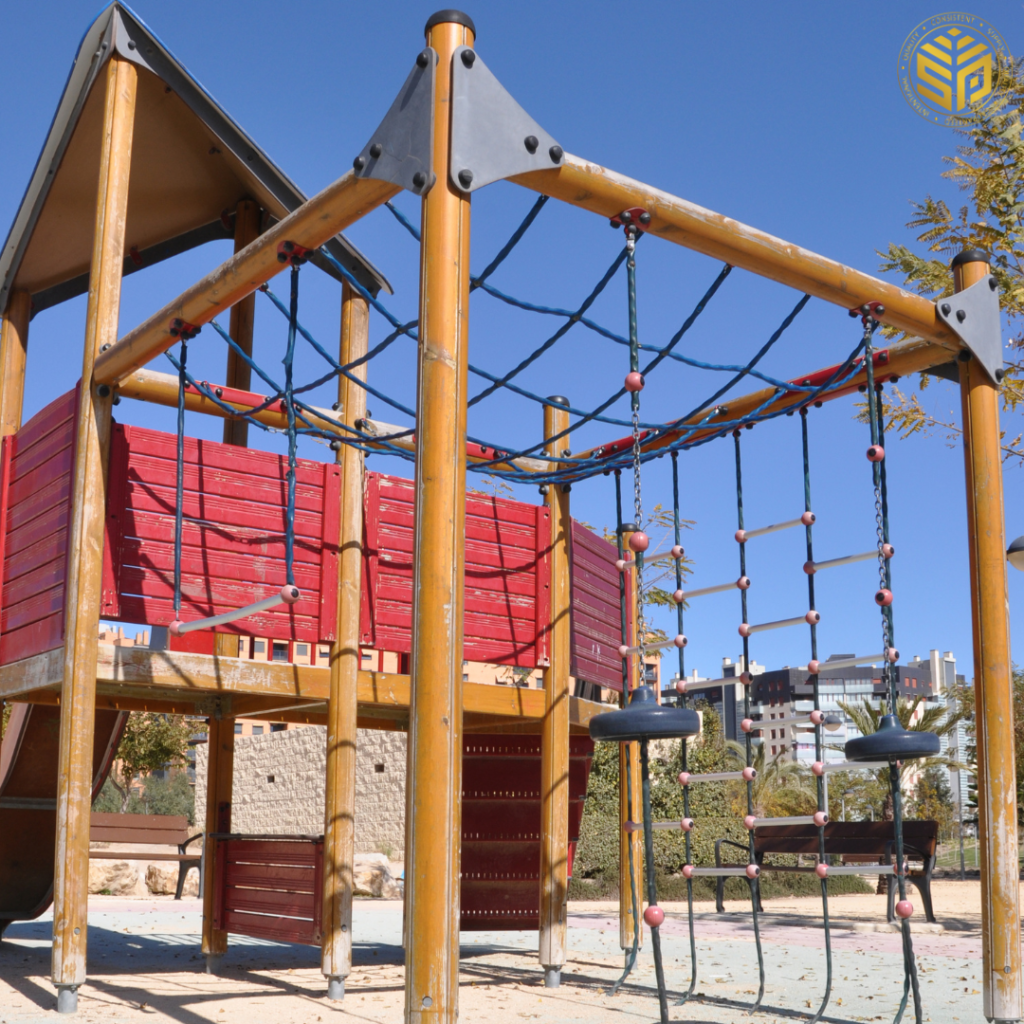
Using CCA Gum Poles for Playgrounds
The chemicals used for CCA gum poles do not leak, making them safe to use as structures such as jungle gyms for children to play on. Jungle gyms come in many shapes and sizes. Poles also come in different shapes and sizes making them ideal for unique playground projects. For some tips, read our blog by clicking on this link: Jungle Gyms, Water Entertainment Structures
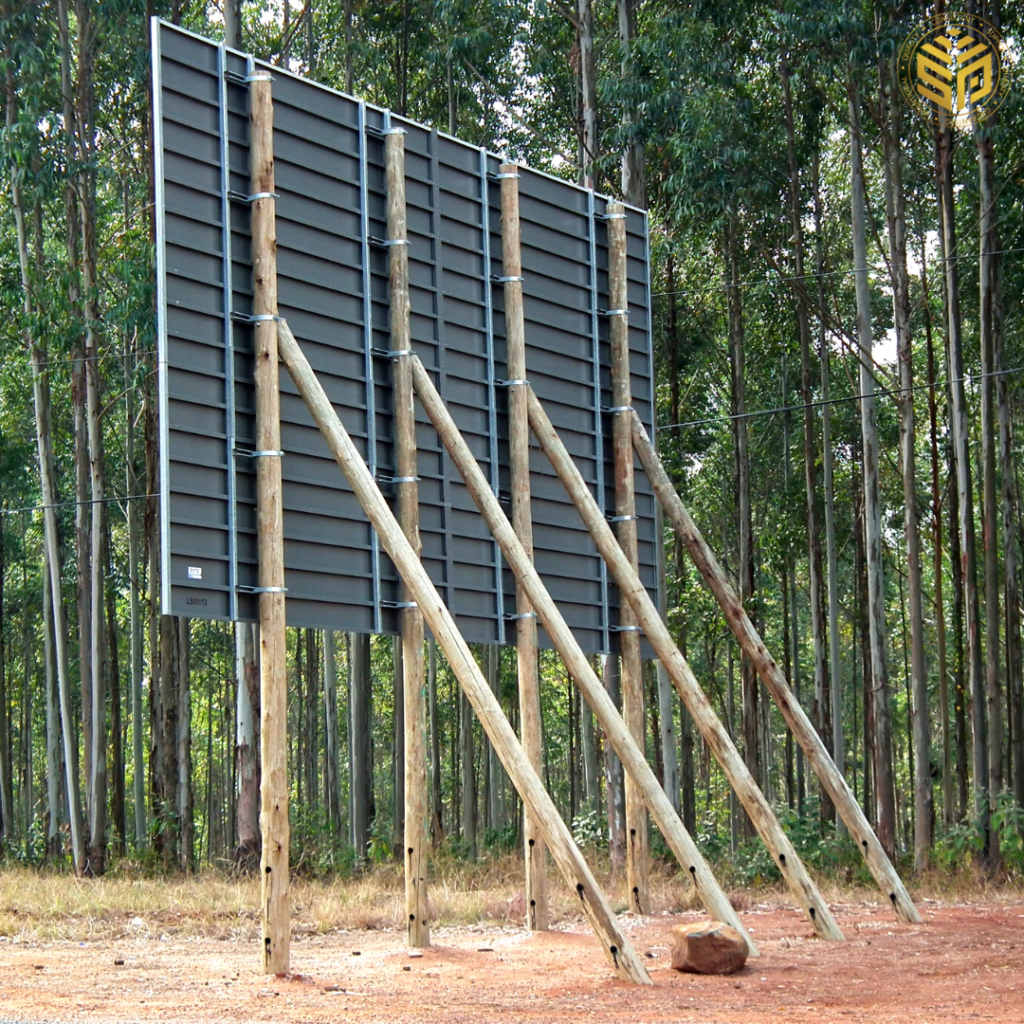
Sign posts
Poles can be used to hold up a sign next to the road or any other place. CCA gum poles work well with this application because they can withstand the weathering element, making them durable. CCA gum poles are also strong enough to hold the weight of a signboard and steel frame.
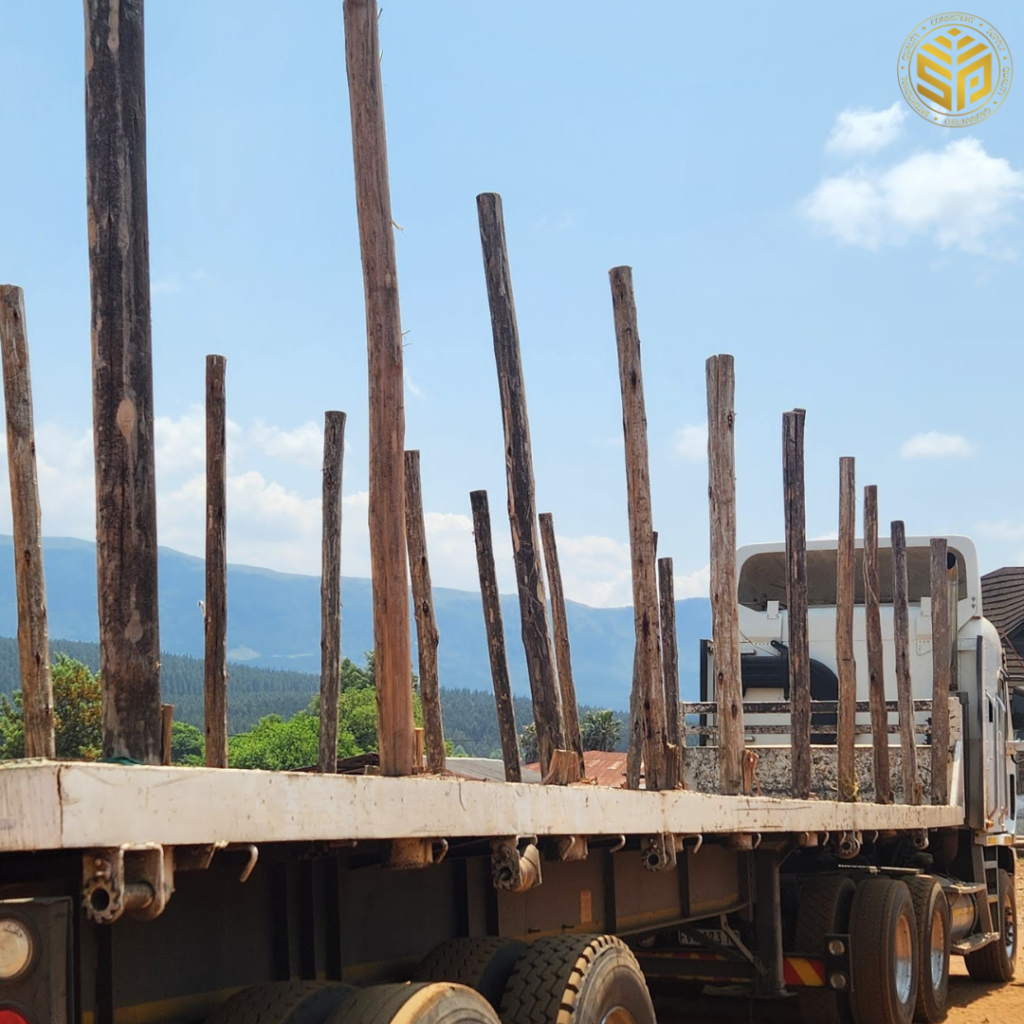
Truck Uprights
Transporting poles is a huge responsibility. The most important aspect of transporting poles is to ensure that the timber is completely secure while on the road. Many forestry businesses use poles as uprights on their trucks to keep the poles in place. This method works well and is very cost-effective.
Optic Fibre Poles
The chemicals that are used to treat poles contain Copper and Chrome, these elements act as good conductors of lightning. In other words, the copper and chrome offer a low resistance path to the lightning allowing it to pass through the ground without impacting the pole.
CCA gum poles are also strong and durable
Using CCA gum poles for Furniture & DIY
Eucalyptus is a hardwood and because it is treated, the furniture can be used inside or outside. fore example, you can build log pole furniture with CCA pressure-treated material which is highly durable and extremely cost-effective. Log pole furniture is handcrafted and unique to suit the client’s needs. Eucalyptus is a hardwood which means you can build high-quality furniture while saving on costs.
Pole log furniture is mainly assembled inside the house and fixed to the walls. Log furniture which will be permanently used outside needs to be created for protection against the weather and insects.
They may need to be varnished or stained to minimize dust attraction and for extra protection against products that may stain or damage the furniture. Pole log furniture is eminent for its rustic look.
Laths are the perfect material for garden furniture. It’s easy to work with and very durable.

Using CCA gum poles in your garden
- Wall Retainers
Wall retainers serve an important role to keep your garden neat and soil in place. CCA poles is protected against insects and they are relatively tolerant to moisture making them highly durable. Consequently, their are perfect for this application.
Retaining walls built with CCA gum poles are just as strong as concrete retaining walls. However, CCA gum poles are more beneficial as there is no destruction to the natural look of your garden, wood just naturally blends in.
- Garden edging
Garden edging is used to separate the edges between a flowerbed or lawn and a pathway. It is effective because it can keep a flowerbed intact by preventing it from changing shape. Droppers work perfectly well for this application.
- Garden Fences
Garden fences can be used as protection for a garden. They are very effective for protecting your garden against people or animals by preventing them from walking through the garden. furthermore, It can also protect your garden from damage caused by strong winds.
Using poles for your garden fence is cost-effective and blends beautifully in with the natural look. CCA-treated poles will also last longer because it tolerates moisture and is strong and durable.
- Raised garden beds
The benefit of garden beds is that the soil is less compacted which means better drainage and a better chance that the plants will start to grow earlier in the season. They are mainly used for vegetable and herb gardens.

Using CCA gum poles for Décor
- Partitions
You can build a partition for extra privacy or to help add functionality by breaking the space up into sections. You can do this by using laths. It can also enhance the natural aesthetic theme in a room.

- Wall and ceiling
You can successfully incorporate laths into your landscape design, which creates an aesthetically pleasing result.
For example, you can complement a ceiling or wall by tying a space together using CCA gum poles or laths. or you can create a backdrop that functions as a focal point, you can use. Eucalyptus poles and laths can be used as ceiling treatments such as coffers, to increase the visual appeal of a room.
- Support for string lights
This is a perfect DIY project. Many use Light string lights for indoor as well as outdoor décor in the event of special occasions like Christmas. You can use CCA gum poles for this project because they are treated for inground contact, you can also easily remove and install these poles.
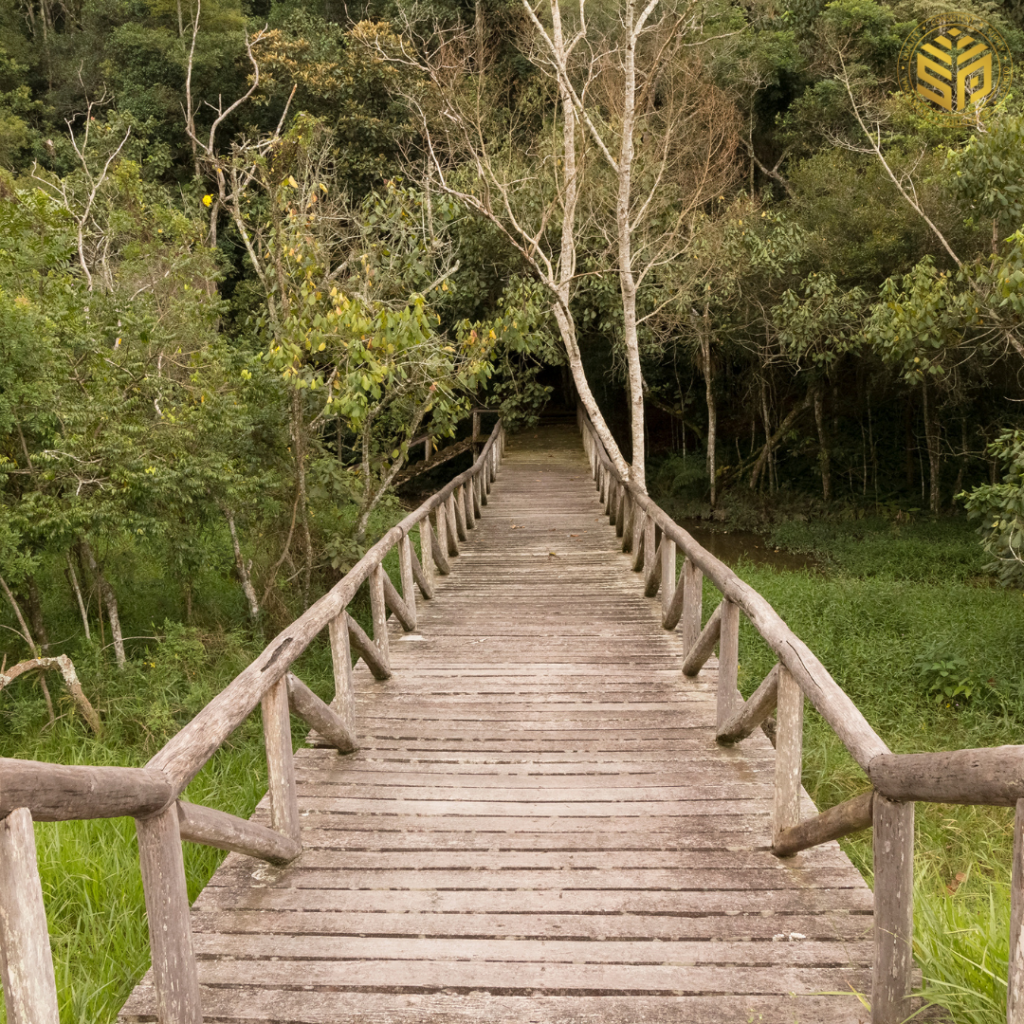
Using CCA gum poles for Jetties and walkways
People use jetties to connect the land with deep water farther away from shore for docking ships and unloading cargo. They can also serve as a walkway into the water. Walkways allow you to reach certain hard-to-get places.
You can use CCA gum poles as piles to support a jetty or walkway. Furthermore, CCA gum poles or droppers can also function as guard rails on walkways to prevent any unwanted accidents. If you feel like covering up your railings, you can use laths as cladding.
CCA gum poles are available at Sabie Poles
Our CCA gum poles go through multiple grading and testing processes to ensure that we offer the best quality pole product possible. Furthermore, we follow all the necessary protocols to ensure our products meet the standards required by national law. Thus, you can rest assured that you will receive a superior quality product from a trusted supplier.
Our CCA gum poles come in a variety of lengths and diameters as indicated below:
- 32mm -49mm : 1.2m – 3.0m
- 50mm – 74mm : 1.2m -6.0m
- 75mm -99mm : 1.2m – 9.0m
- 100mm -124mm : 1.2m -15m
- 125mm -149mm : 1.2m -15m
- 150mm – 174mm : 1.2m -15m
- 175mm -199mm : 1.2m -15m
- 200mm – 224mm : 1.2m -15m
Available sizes for laths are 3.0m, 3.6m, and 4.5m with a diameter of 20-32mm
Available sizes for droppers are 1.2m, 1.5m, 1.8m, 2.1m, 2.4m, 2.7m, and 3.0m lengths with a small end diameter of 32-49mm.
Delivery
We have been successfully exporting timber to all the Southern African Development Communities (SADC countries) and internationally for more than 27 years. We also deliver locally.
Our timber products are available at our factory in Sabie – 25 Bandsaag weg, Sabie and at these hardware stores: BUCO Nationwide. ZJ Essential hardware stores in Mpumalanga and Gauteng, Build-it Hoedspruit, and Mpumalanga timbers in Nelspruit.


